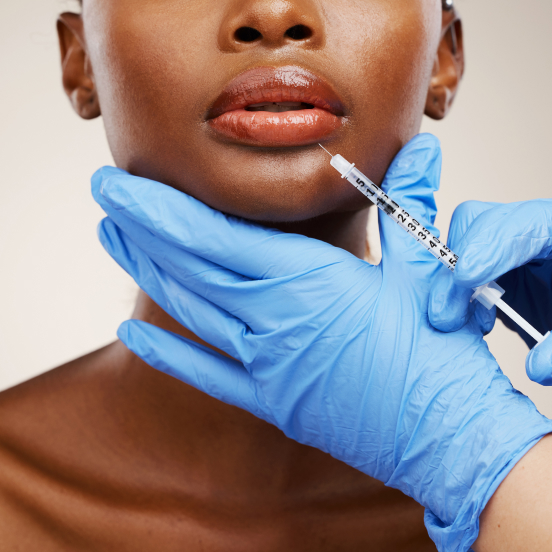COSMETICS
Dermal Fillers
Dermal fillers are injectable substances that can restore volume to the face, earlobes, and hands and reshape and augment the lips, nose, and chin.
Many women and men elect to have dermal fillers as a safe and effective option for facial rejuvenation.
Before making the decision to seek fillers to address wrinkles, folds, and hollowness, it’s important for patients to properly educate themselves about the treatment and different product options.

-
What Are Dermal Fillers?
Dermal fillers are synthetic or naturally-occurring substances that are injected into the body’s soft tissue at different depths to lift, plump, and contour the face, hands, earlobes, and parts of the body.
They often allow patients to improve their appearance and look refreshed without the downtime, risks, and commitment of surgery.
-
Dermal Filler Uses
Patients often seek dermal fillers for a variety of facial issues including:
- Forehead lines
- Hollowness of the cheeks, under eyes, and temples
- Sagging or flattened cheeks
- Deep folds from the nose to the mouth (nasolabial folds)
- Prominent lines from the corners of the mouth to the chin (marionette lines)
- Thin lips
- Vertical lines around the mouth (smoker’s lines)
- Nasal deformities
- Acne depressions
Fillers can also provide volume restoration in the earlobes and hands.
-
Candidates
Healthy men and women over the age of 21 that have any of the above-mentioned concerns are often good candidates for dermal fillers.
Being a non-smoker is also advantageous when considering any aesthetic treatment.
In addition, fillers are an excellent treatment option for patients that want a quicker onset of results, are opposed to surgical intervention, require only mild to moderate correction, and have tried and are dissatisfied with other non-invasive options.
-
Contraindications For Dermal Fillers
Patients that are pregnant or breast-feeding should postpone treatment and consult with their obstetrician to determine when they can safely proceed with dermal fillers.
In addition, individuals with active acne, a history of severe allergies and anaphylaxis, and/or autoimmune diseases are not ideal candidates for dermal fillers.
-
Hyaluronic Acid Dermal Fillers
Most temporary dermal fillers are composed of hyaluronic acid which is a naturally-occurring chemical predominantly found in skin and connective tissues.
Hyaluronic acid is highly effective as a dermal filler because of its ability to transport nutrients to skin.
Additionally, this substance is hydrophilic and plumps facial areas by pulling water to the skin’s surface.
Hyaluronic acid is absorbed by the body within six-to-12 months. -
Other Types Of Dermal Fillers
While hyaluronic acid fillers are most commonly used, other types of dermal fillers include:
Calcium hydroxylapatite (Radiesse), porcine/bovine-based collagen (Evolence, Zyderm, Fibrel), human-based collagen (Cosmoderm, Cosmoplast), poly-L-lactic acid (Sculptra), polymethylmethacrylate (Artefill), polyacrylamide (Aquamid), and a fat transfer. -
Preparing For Dermal Fillers
Selection of a skilled and experienced injector is essential before undergoing a dermal filler treatment.
It’s also important for patients to discontinue blood thinning products like aspirin, non-steroidal anti-inflammatory drugs (NSAIDS include Advil and Aleve), and vitamin E supplements.
In addition, patients should eat leafy greens, follow a low sodium diet, and avoid strenuous exercise several days before and after their injections.
-
Treatment Process
Depending on the areas being injected, treatment time is approximately 10-25 minutes.
The injector may apply a topical anesthetic beforehand, and many dermal fillers contain lidocaine to minimize pain.
-
Recovery
Immediately after receiving dermal fillers, patients may experience redness, swelling, bruising, and lumps at or near the injection site. These effects often subside within two-to-four weeks depending on the product used.
Patients should also avoid contact sports and strenuous exercise, massage the area, use arnica montana, and sleep on their backs for a few days post-treatment to minimize swelling and bruising.
-
Dermal Filler Results
Dermal filler results can be noted several days after receiving the injections.
However, it can take up to two-to-four weeks to see the full effects, and providers often request that patients return for follow-up to assess the outcome.
Most hyaluronic acid fillers last six-to-12 months and Juvederm Vollure XC can last up to 18 months.
For additional information about dermal fillers including Restylane and Juvederm products, please call our office today for an appointment. -
Juvederm Dermal Fillers
The Juvederm collection of hyaluronic acid dermal fillers is manufactured by Allergan–the company that’s also responsible for Botox.
Their products include Juvederm XC, Juvederm Voluma XC, Juvederm Vollure XC, Juvederm Ultra XC, and Juvederm Volbella XC. The XC indicates that the filler contains lidocaine to help ease discomfort during the injection.
Juvederm Voluma XC is tailored to treat age-related volume loss in the cheeks.
Juvederm Ultra XC was created to plump lips for added fullness. For a subtler lip enhancement or to soften lines around the mouth, Juvederm Volbella delivers natural results.
-
Newest Addition To The Juvederm Family
For moderate to severe facial lines and wrinkles, Juvederm Vollure XC can be injected to smooth and refresh skin.
Juvederm Vollure XC, like Juvederm Voluma XC and Juvederm Volbella XC, uses a special Vycross technology to link hyaluronic acid molecules that differ in weight.
In addition, Juvederm Vollure XC is the only hyaluronic acid filler that’s FDA-approved to last 18 months.
Restylane Page of Complete Guide to Dermal Fillers
-
Newest Addition To The Restylane Family
Restylane Refyne and Defyne are the newest hyaluronic acid fillers that use an innovative XpresHAn technology.
These unique products provide lifting and plumping, while also maintaining facial flexibility and expression.
Restylane Refyne is used to correct mild to moderate smile and laugh lines, while Restylane Defyne is best for deeper furrows and facial lines.